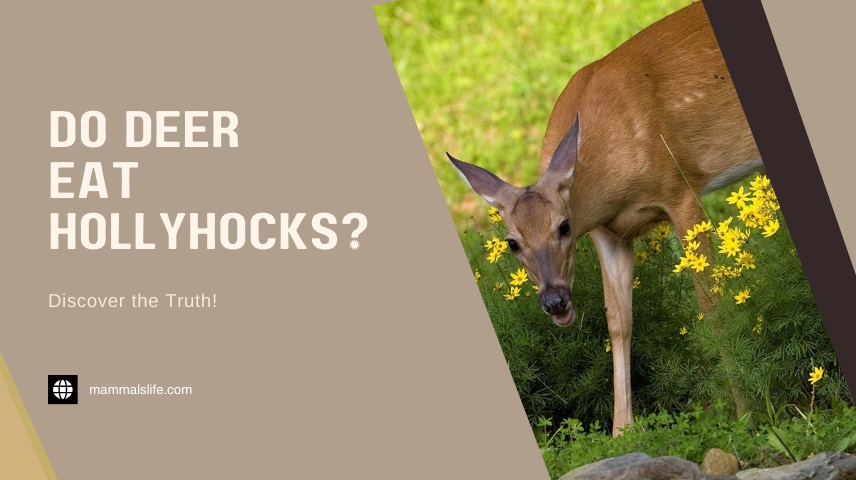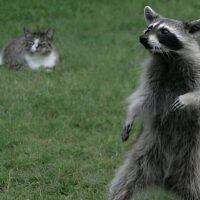Last Updated on February 22, 2025 by Mammals Life
Yes, deer eat hollyhocks. They find the plants appealing and often graze on them.
Deer pose a significant challenge for gardeners. These graceful animals have a voracious appetite, and their preferred diet includes a variety of plants. Hollyhocks, with their tall stalks and vibrant blooms, are particularly attractive to deer. Gardeners often find their hollyhocks damaged or completely eaten.
To protect these plants, consider using deer repellents or physical barriers. Some gardeners opt for deer-resistant plants to minimize damage. Understanding deer behavior and their dietary preferences can help in creating a deer-resistant garden. By taking proactive measures, you can enjoy a beautiful garden without the constant threat of deer damage.
Introduction To Hollyhocks
Hollyhocks are tall, beautiful flowers that catch the eye. Their vibrant colors brighten any garden. Many wonder if deer find them tasty. Let’s start by learning more about hollyhocks.
Origins And Characteristics
Hollyhocks belong to the Malvaceae family. Their scientific name is Alcea rosea. These plants are native to Asia and Europe. They can grow up to 8 feet tall. Hollyhocks come in a variety of colors, including pink, red, yellow, and white. Their large, round petals form a beautiful display. These flowers bloom in the summer and attract bees and butterflies.
Growing Conditions
Hollyhocks thrive in full sun. They need at least six hours of sunlight each day. These flowers prefer well-drained soil. They can tolerate dry conditions but need regular watering during growth. Hollyhocks do well in zones 3 to 9. Plant them in the spring or fall for the best results.
| Characteristic | Details |
|---|---|
| Scientific Name | Alcea rosea |
| Family | Malvaceae |
| Height | Up to 8 feet |
| Sunlight | Full sun |
| Soil | Well-drained |
| Zones | 3 to 9 |
Use these tips to grow healthy hollyhocks. They will add beauty and charm to your garden. The next question is, do deer eat hollyhocks?
Deer Feeding Habits
Deer have diverse diets that change with the seasons. They eat a wide range of plants. Understanding their feeding habits can help protect your garden.
Diet In The Wild
In the wild, deer consume grasses, leaves, and twigs. They also eat fruits and nuts when available. Their diet includes acorns, berries, and mushrooms. Deer prefer plants rich in nutrients.
| Season | Food Source |
|---|---|
| Spring | Fresh grasses, buds, and leaves |
| Summer | Fruits, flowers, and crops |
| Fall | Acorns, nuts, and mushrooms |
| Winter | Bark, twigs, and dried grasses |
Seasonal Preferences
Deer change their diet with the seasons. In spring, they eat fresh grasses and young shoots. Summer brings fruits and flowers to their diet. Fall offers acorns and nuts, which are high in energy. Winter forces them to eat bark and twigs.
- Spring: Fresh grasses, buds, and leaves
- Summer: Fruits, flowers, and crops
- Fall: Acorns, nuts, and mushrooms
- Winter: Bark, twigs, and dried grasses
Understanding these habits can help protect your hollyhocks. Deer might eat them during certain seasons.
Do Deer Eat Hollyhocks?
Many gardeners worry about deer eating their plants. One common question is: Do deer eat hollyhocks? Hollyhocks are beautiful flowers that can add charm to any garden. But, can they survive deer visits? Let’s find out.
Evidence From Gardeners
Many gardeners have shared their experiences with deer and hollyhocks. Some say deer love to munch on these flowers. Others claim their hollyhocks are untouched. Here are some common observations:
- Deer often eat hollyhocks in rural areas.
- Hollyhocks near forests are more likely to be eaten.
- Some gardeners use sprays to keep deer away.
- Others plant hollyhocks in fenced areas.
Deer behavior can vary by region. Gardeners should note their local deer habits.
Scientific Studies
Scientists have studied deer eating habits. Studies show that deer are more likely to eat certain plants. But do they eat hollyhocks?
Here is what some studies found:
| Study | Findings |
|---|---|
| Study A | Deer prefer tender plants over woody plants. |
| Study B | Deer eat plants with high water content. |
| Study C | Deer avoid plants with strong scents. |
Hollyhocks are tender and have high water content. This makes them attractive to deer. But they lack strong scents, so they are not always the first choice.
Protecting Hollyhocks From Deer
Deer love munching on hollyhocks, which can be frustrating for gardeners. Protecting these beautiful flowers from deer is essential. There are several methods to keep deer away from your hollyhocks. Below, we explore some effective strategies.
Physical Barriers
Physical barriers are an excellent way to protect hollyhocks. Here are some options:
- Fencing: Build a tall fence around your garden. Deer can jump high, so a fence should be at least 8 feet tall.
- Netting: Use garden netting to cover your hollyhocks. This keeps deer from reaching the plants.
- Row Covers: Lightweight row covers can shield hollyhocks from deer. These covers are easy to install and remove.
Natural Deterrents
Natural deterrents can also help keep deer away from hollyhocks. Consider these options:
- Plants: Plant deer-resistant plants around your hollyhocks. Plants like lavender, sage, and marigold can deter deer.
- Scents: Use strong scents to repel deer. Garlic, mint, or human hair can be effective.
- Sprays: Homemade or commercial deer repellent sprays work well. Spray them on and around your hollyhocks.
Combining these methods increases the chances of protecting your hollyhocks. Deer will find it harder to access and eat your flowers.
Alternative Deer-resistant Plants
Deer often munch on garden plants, causing frustration for gardeners. If deer frequently visit your garden and nibble on your hollyhocks, consider planting deer-resistant alternatives. These plants can still beautify your garden while keeping deer at bay.
Perennials
Perennials are plants that return year after year. Here are some deer-resistant options:
- Lavender: Deer dislike its strong scent.
- Yarrow: Its bitter taste deters deer.
- Russian Sage: Deer avoid its aromatic leaves.
- Catmint: This plant has a strong aroma that deer don’t like.
Annuals
Annuals need replanting each year but can add vibrant color to your garden. Here are some deer-resistant annuals:
- Marigolds: Deer find their scent unpleasant.
- Zinnias: These flowers are usually left alone by deer.
- Snapdragons: Deer avoid eating them due to their taste.
- Geraniums: Their strong smell keeps deer away.
Below is a table summarizing these plants:
| Plant Type | Plant Name | Deer Resistance Feature |
|---|---|---|
| Perennial | Lavender | Strong scent |
| Perennial | Yarrow | Bitter taste |
| Perennial | Russian Sage | Aromatic leaves |
| Perennial | Catmint | Strong aroma |
| Annual | Marigolds | Unpleasant scent |
| Annual | Zinnias | Usually left alone |
| Annual | Snapdragons | Unpalatable taste |
| Annual | Geraniums | Strong smell |
Frequently Asked Questions
Do Deer Eat Hollyhocks?
Yes, deer find hollyhocks quite tasty and often eat them.
How To Protect Hollyhocks From Deer?
Use deer repellents, fencing, or netting to keep deer away from hollyhocks.
Are Hollyhocks Deer Resistant?
No, hollyhocks are not deer resistant and are often eaten by deer.
What Other Plants Deter Deer?
Plants like lavender, rosemary, and marigolds can help deter deer from your garden.
Conclusion
Deer can eat hollyhocks, especially if food is scarce. Protect your garden with fencing or deer repellents. Choose deer-resistant plants to minimize damage. Understanding deer behavior helps in safeguarding your hollyhocks. Enjoy a beautiful, thriving garden by staying vigilant and proactive.








